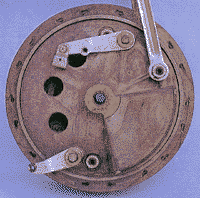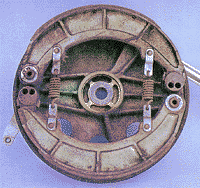
The following is taken from an article entitled, "ITALIAN COMPETITION BRAKES" written by GIANNI PERRONE. I wish to give the author full credit for his wonderful work, and am only reprinting this material to make it accessible to more motorcycle enthusiasts.

Front view of the 230 mm Ceriani front brake.
The Ceriani Company, which was already in the racing and sports motorcycle business as a manufacturer and distributor of front forks and special shock absorbers, began to produce special brakes in 1968.
The Ceriani brakes were produced in only one diameter: 230 mm both front and back. There were two versions of the front brake - wide and narrow. The narrow was suited to medium capacity and was fitted as standard to the competition 250/350 Aermacchi Ala díOro; later the wider size was developed, which differed from the first in the size of the shoes (and therefore of the braking area) and externally in the larger cooling air-intake.

External view of the Ceriani front brake (diameter 230 mm). The two shoe plates were of magnesium alloy and the hub of aluminium.
The larger model was fitted originally only to the MV three cylinder of Agostini, but some were later sold to certain selected riders (I was the first); after that they were regularly placed on sale. They were fitted to all the Laverda SFCs of those years, until the arrival of disc-brakes.
The Ceriani drum brakes were the finest ever produced; they were resistant to fading, highly efficient and free from problems of cracking of the cast iron inserts which had always afflicted the racing drum brakes and were rugged enough to stand up to the punishment of racing, lasting the 24 hours very well on the not-so-light Laverda 750 SFC in the Endurance races.

Two leading shoes were attached to each shoe plate (there were two actuating cams connected by external linkage).
The brakes on the medium capacity bikes were probably in danger of braking too well (!) and the best cared-for bikes of that era fitted Fontana brakes front and Ceriani rear, because the rear Fontana had the defect of breaking-up.
Ceriani finished producing brakes without ever making discs and that was a pity. Iím convinced that he would have made very good ones, because every product the factory made was of the highest quality and superior to that of the competition, whether for brakes or for suspensions, which latter field is an area in which he is still active, though under a different name, and supplies the top Italian racing motorcycles: MBA, Garelli, Cagiva, Bimota, etc.
![]()